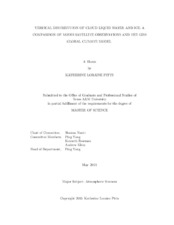| dc.description.abstract | Clouds continue to be a large source of uncertainty within global climate models. While satellites provide the only global datasets for comparison with these models, satellite retrievals provide inferences of cloud properties, rather than direct measurements. Therefore, comparisons between climate model simulations and satellite retrievals require careful construction of globally-gridded and time-averaged (Level 3) satellite datasets. For some types of comparisons, existing Level 3 datasets may not be sufficient, necessitating the generation of gridded datasets directly from Level 2 products.
The current study uses a filtering and gridding algorithm to create a customized globally-gridded (i.e., Level 3) dataset based on Aqua MODIS Level 2 cloud top pressure and cloud optical property retrievals. With the recent release of MODIS Collection 6, we utilize this algorithm to examine the differences between cloud parameters in the MODIS Collection 5 and Collection 6 datasets, and then compare these satellite measurements to the GISS-E2-H model-simulated cloud parameters that were provided for the Coupled Model Intercomparison Project - Phase 5 (CMIP5). This comparison study focuses on the vertical distribution of cloud liquid water and ice, especially in the mid-troposphere where mixed-phase clouds are most likely to occur.
Results show that the cloud retrieval algorithm improvements with MODIS Collection 6 lead to an overall decrease in uncertainty in cloud water path retrievals, as well as a change in the vertical distribution of clouds (high clouds higher, low clouds lower) and the resulting vertical distribution of cloud water path (increased mid-level cloud water path). When MODIS Collection 6 data are compared with GISS-E2-H climate model simulations, it is clear that the model greatly overestimates ice water path within a double ITCZ (intertropical convergence zone) in the high cloud height regime, but underestimates ice water path in higher latitudes. The model also overestimates low level liquid water path over land, especially over mountainous regions.
The filtering and gridding algorithm used in this study is a convenient tool for building custom gridded datasets to address research questions that the official Level 3 datasets were not designed for. | en |


